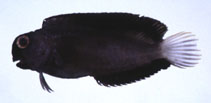| Family: |
Blenniidae (Combtooth blennies), subfamily: Salariinae |
| Max. size: |
14.5 cm TL (male/unsexed) |
| Environment: |
reef-associated; marine; depth range 1 - 20 m |
| Distribution: |
Western Central Pacific: southern portion. |
| Diagnosis: |
Dorsal spines (total): 10-10; Dorsal soft rays (total): 19-21; Anal spines: 2-2; Anal soft rays: 18-20; Vertebrae: 33-34. Juveniles uniformly yellowish (Ref. 1602), adults dark brown to black (Ref. 37816). |
| Biology: |
Lives among branches of live and dead corals of sheltered shallow reefs (Ref. 2334). Oviparous. Eggs are demersal and adhesive (Ref. 205), and are attached to the substrate via a filamentous, adhesive pad or pedestal (Ref. 94114). Larvae are planktonic, often found in shallow, coastal waters (Ref. 94114). |
| IUCN Red List Status: |
Least Concern (LC); Date assessed: 01 April 2012 Ref. (130435)
|
| Threat to humans: |
harmless |
Source and more info: www.fishbase.org. For personal, classroom, and other internal use only. Not for publication.
